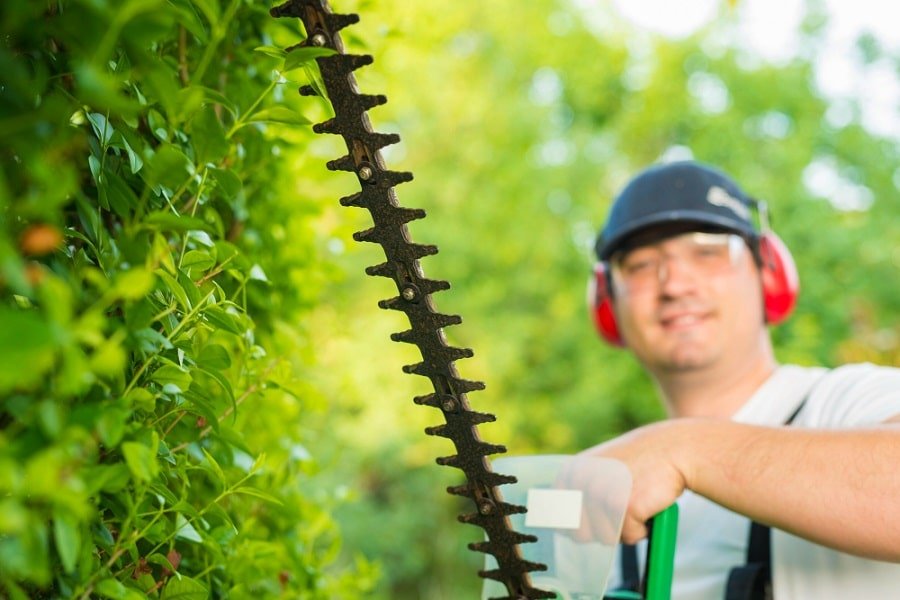What is the Difference Between a Hedge Trimmer and a Hedge Cutter?

If you’re a homeowner or a gardener, you’ve probably come across the terms “hedge trimmer” and “hedge cutter” before. At first glance, these two terms may seem interchangeable, leading many people to wonder if there is any difference between the two.
In this blog post, we will shed light on the distinction between a hedge trimmer and a hedge cutter. We will explore their unique features, functionalities, and uses, helping you make an informed decision when it comes to your own gardening needs.
Hedge Trimmer: The Versatile Tool for Precision Trimming
Understanding Hedge Trimmers
A hedge trimmer is a power tool specifically designed for trimming and shaping hedges, shrubs, and bushes. It typically consists of a motor, a cutting blade, and a handle that allows for easy manoeuvrability. Hedge trimmers come in different variants, including electric trimmers, battery-powered trimmers, and gas-powered trimmers. These variations are designed to cater to different user preferences and requirements.
Features and Uses
Hedge trimmers predominantly feature reciprocating blades, which move back and forth rapidly to cut through hedge branches with precision. The blades are usually long and slim, allowing for accurate and controlled cutting. This makes hedge trimmers the ideal tool when you need to sculpt hedges into specific shapes or create clean, straight lines.
Hedge trimmers are incredibly versatile and can be used for a wide range of horticultural tasks. Apart from shaping hedges, they can also trim shrubs, prune branches, and even tackle taller plants if you have access to an extendable or telescopic hedge trimmer. Their lightweight design and manoeuvrability make them suitable for both small and large gardens, ensuring you can easily reach all areas that need attention.
Tips for Using a Hedge Trimmer
To ensure a smooth and effective trimming experience, consider the following tips when using a hedge trimmer:
- Safety First: Always wear protective gear such as goggles, ear defenders, and gloves to safeguard yourself during operation.
- Timing Matters: Trim hedges during the appropriate seasons to avoid disturbing nesting birds and migratory creatures that may seek refuge in the foliage.
- Starting Off Right: Begin by trimming the sides and the top of the hedge, working your way from the bottom to create a tapered shape.
- Avoid Overreaching: Use a ladder or an extendable trimmer when dealing with tall hedges. Stretching beyond your reach can lead to accidents or uneven trimming.
- Regular Maintenance: Keep your hedge trimmer in good condition by regularly cleaning the blades, lubricating moving parts, and inspecting for any loose or damaged components.
Remember, hedge trimmers excel at precision and intricate trimming tasks, allowing you to sculpt your hedges to perfection.
Hedge Cutter: The Robust Tool for Tackling Thick Vegetation
Understanding Hedge Cutters
Unlike hedge trimmers, which are primarily focused on shaping hedges, hedge cutters are designed to handle thicker vegetation, including branches and woody stems. Hedge cutters, also known as hedge clippers or hedge shears, come in several variations, including manual cutters, electric cutters, and gas-powered cutters. The choice of hedge cutter largely depends on the density and size of the vegetation you need to cut.
Features and Uses
Hedge cutters feature larger and more robust blades compared to hedge trimmers. These blades are often serrated to aid in cutting through tough branches. Hedge cutters can be manual, operated by hand, or powered by electricity or gasoline. Motorized hedge cutters provide more cutting force, making them suitable for heavy-duty tasks and larger hedges.
The primary purpose of a hedge cutter is to remove thicker or overgrown branches, ensuring that your hedges remain healthy and well-maintained. Hedge cutters are commonly used for rejuvenating old hedges, rejuvenation pruning, and large-scale trimming.
Tips for Using a Hedge Cutter
When utilizing a hedge cutter, consider the following tips to optimize your cutting experience:
- Safety Precautions: Wear protective equipment, including gloves and safety glasses, to avoid injuries from flying debris.
- Select the Right Blade: Hedge cutters offer different blade options, such as straight blades for smooth cutting and wavy blades for improved grip on thicker branches. Choose the appropriate blade type based on your specific cutting requirements.
- Know Your Target: Identify the branches or stems that need trimming and focus on those areas to avoid unnecessary damage to the rest of the hedge.
- Use the Correct Technique: Make clean and precise cuts by positioning the blades correctly. Hold the hedge cutter at a slight angle to ensure a smooth cutting motion.
- Maintenance and Care: After each use, clean the blades thoroughly, removing any plant residue or debris. Sharpen the blades as needed to maintain optimal cutting performance.
Hedge cutters are perfect for tackling thicker vegetation and heavy-duty trimming tasks. They allow you to maintain the health and aesthetic appeal of your hedges, even when faced with challenging growth patterns.
Hedge Trimmer vs. Hedge Cutter: Which One to Choose?
Now that we have explored the unique features and uses of hedge trimmers and hedge cutters, it’s time to consider which tool suits your specific needs. But before we do that, let’s summarize the key differences between the two:
- Hedge trimmers excel at precision trimming and shaping tasks, making them ideal for clean lines and intricate designs.
- Hedge cutters, on the other hand, are better equipped for cutting thicker vegetation, including branches and woody stems.
When choosing between a hedge trimmer and a hedge cutter, take the following factors into account:
- Hedge Type: Consider the type and density of the hedges you will be dealing with. If you have well-maintained hedges that require regular shaping and delicate pruning, a hedge trimmer is the way to go. For older hedges with thicker branches or overgrown vegetation, a hedge cutter will be more effective.
- Garden Size: Determine the size of your garden or the area you need to trim. Hedge trimmers are generally lighter and more manoeuvrable, making them suitable for larger areas. In contrast, hedge cutters may be more suitable for smaller gardens with dense hedges that require more forceful cutting.
- Task Complexity: Evaluate the complexity of the trimming tasks you regularly undertake. If you focus on creating symmetrical patterns or intricate designs, a hedge trimmer’s precision and control will be invaluable. However, if you often find yourself dealing with overgrown and tangled branches, a hedge cutter’s cutting power will be indispensable.
Conclusion
While the terms “hedge trimmer” and “hedge cutter” are often used interchangeably, there are distinct differences between the two tools. Hedge trimmers are designed for precision trimming and shaping, allowing you to create clean lines and detailed designs. On the other hand, hedge cutters are more robust and powerful, making them suitable for cutting through thicker branches and overgrown vegetation.
Understanding your specific gardening needs, including hedge type, garden size, and task complexity, will help you determine whether a hedge trimmer or a hedge cutter is the right tool for you. By making an informed choice, you can ensure that your hedges remain healthy, well-maintained, and aesthetically pleasing.
Remember, whether you opt for a hedge trimmer or a hedge cutter, always prioritize safety, follow the manufacturer’s instructions, and perform regular maintenance to keep your tool in optimal condition. Enjoy the process of transforming your hedges into beautifully sculpted garden features!
FAQs
Which tool is better for precise shaping?
Hedge trimmers are better for precise shaping due to their dual reciprocating blades.
Can I use a hedge cutter for light-trimming tasks?
Yes, manual hedge cutters are suitable for light trimming, but powered hedge cutters are more efficient for heavier tasks.
Are gas-powered hedge trimmers loud?
Yes, gas-powered hedge trimmers tend to produce more noise compared to electric trimmers.
How often should I sharpen the blades of my hedge trimmer?
Regularly inspect the blades and sharpen them when they start to become dull.
Can I use a manual hedge cutter for large hedges?
Manual hedge cutters are more suitable for smaller hedges. For larger hedges, powered hedge cutters are recommended for better efficiency.




